“Summa” – The innkeeper tallying drinks. Ludo Eugen Stieler, an engraving of customer and the tavern owner using chalkboard to add up the bill .
There are way too many variables: condition, location, time of year, present trends in stein collecting, local (and now national) economics, never seen before (therefore no comparables); but most of all = prior expectations by the owner, are among the reasons!
It is now obvious to me the general public never gets that far before wanting to ask me a question on beer stein dollar values.
I just do not have the time. My web site was really started as an informational site for beginning beer stein collectors that would be looking for the info and not the general public.
My SO if one put in “Wood Steins” or “Hand painted steins,” it
STILL ABOUT ANY INFORMATION ON THIS SITE? =
S.C. I. – See: Stein Collector’s International – Web site: http://www.steincollectors.org/
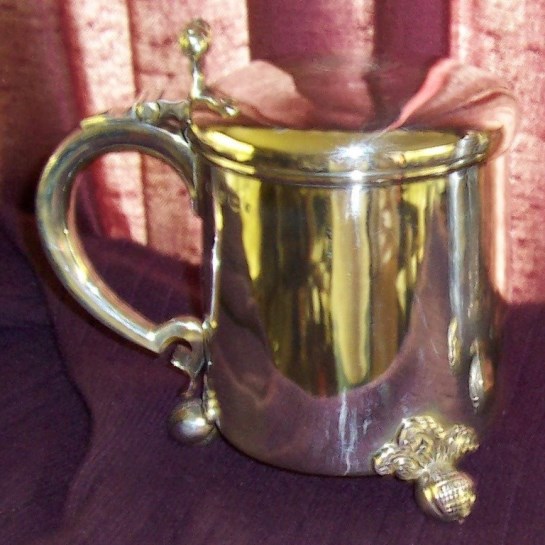 Scottish drinking vessels – There is not much to distinguish Scottish vessels from their English counterparts.
Scottish drinking vessels – There is not much to distinguish Scottish vessels from their English counterparts.
This is a sterling silver Scottish “Peg Tankard” made in Edinbrough, 1902. it has the same appearance as British and Scandinavian models of the same and earlier ages.
 But there are a few differences in a couple of categories. As a lot of their smaller silver tankards are known to have small center of the lid finials that almost look like a lamp finial, especially when made of brass. The one above is modeled after the acorn . [FWTD]
But there are a few differences in a couple of categories. As a lot of their smaller silver tankards are known to have small center of the lid finials that almost look like a lamp finial, especially when made of brass. The one above is modeled after the acorn . [FWTD]
note:finial ON SILVER PLATED photo needed]

Scottish – ale jug Scottish copper ale j ug circa 1830-40 , seamed. Victorian . it was listed on eBay 3-2014, 9.5 inches tall. I think this piece has extremely good lines.
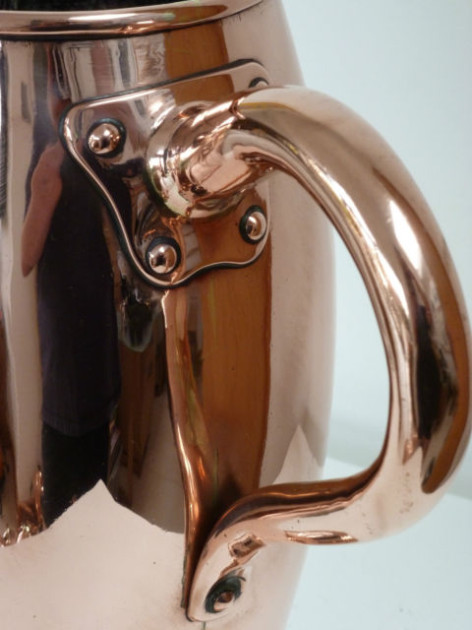
Detail of handle attachment which is quite different from the Russian and Bohemian copper and brass . Certainly doesn’t apply to silver or pewter. I haven’t studied these vessels as much as I should have and don’t know if this mounting is the same for all Britain or not lso of interest is the way the antique Scottish Quaichs (not a mazer) were usually made with wood and wood staves or wood and silver. See: “Quaich” in this compendium, for more examples.
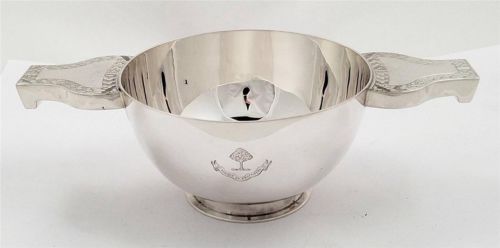
Quaich, Sterling silver – Hallmarked EDINBURGH, 1922 – with engraved (not etched) Armorial Coat of arms ( not a crest!)
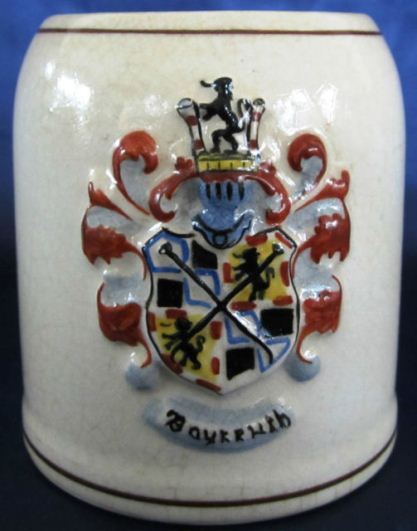
Seiler –Maker of nice porcelain ware. Shown above ▲: 5 liter relief porcelain souvenir mug by Seiler.
. 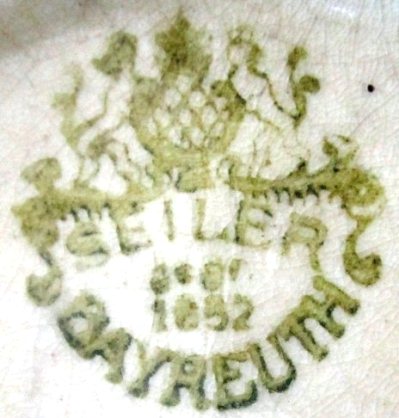
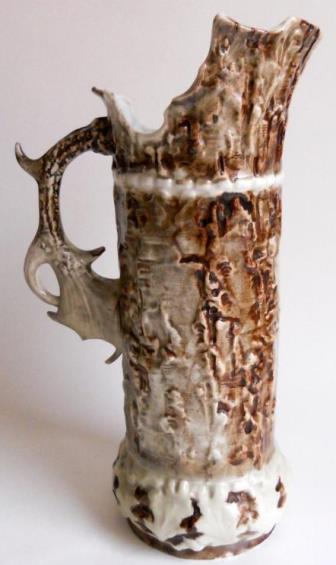
Server – The word “Server” should be used used for the vessel that sits on the table, or nearby small table just for that purpose, that one would use to pour from into a smaller stein, glass or beaker. Servers may or may not have a lid, either attached or “set-on”. Shown above▲” a very unusual molded porcelain beer server with relief scenes showing St. Hubertus and his deer. C. 1900. Unknown maker and one liter in size. A “Pitcher” would be used for a milk or water on the table pouring vessel. “Ewe” is supposed to be just for water for washing one’s hands. Please see the discussion and photos of this word versus Jug at “Jug” in the site’s Compendium.
Seven – crossed – see “Crossed sevens,” in this site’s Compendium for more of a discussion on these 7′s, please see: [Pewter Rules] =http://www.steveonsteins.com/pewter-rules-for-dummies.
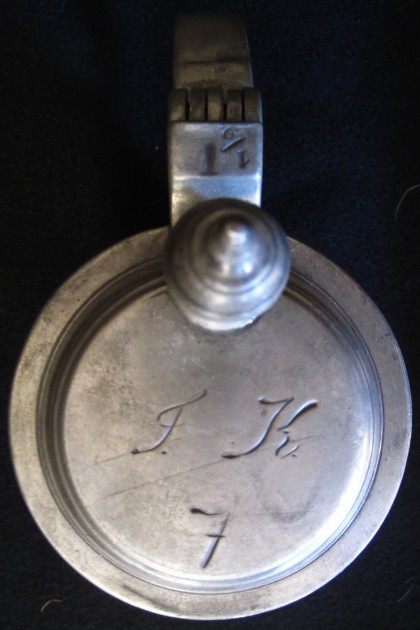
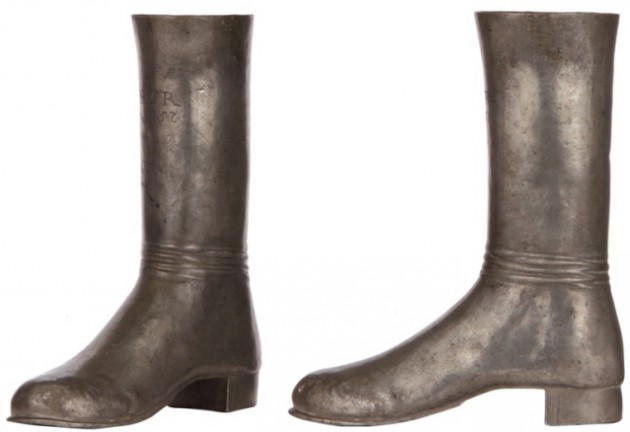
A true boot maker’s guild cup, Dated 1757 on top front of bo0t. I’m sure this one was communal at their meetings and one had to have the same skill on sipping from it as that for an
English “Yard of Ale.” [FWTD]
Below an associated article from the V&A Museum England
: http://www.vam.ac.uk/blog/creating-new-europe-1600-1800-galleries/drinking-to-the-shoemakers
Drinking to the Shoemakers
Author: Dawn Hoskin
With Shoes: Pleasure and Pain now in full swing, I thought it was about time to raise a drink to the shoemakers of 17th and 18th century Europe!
Across Europe, drinking alcohol was deemed essential for the good health and harmony of society at all levels. Rituals, such as toasting and drinking games, were performed using vessels made with a variety of materials and decorative techniques. Drinking rituals encouraged and declared fellowship among men, love between married couples, the loyalty of subjects to their rulers, or in this case allegiance to a guild.
Some of the most magnificent pieces in the Museum’s pewter collections are the former treasures of German craft guilds, most notably their drinking vessels. This particular tankard was made by Joseph Dor in 1704 and belonged to a German shoemakers’ guild. It will be displayed in the Europe Galleries as part of the Drinking display.
Standing on three small round feet, at 50.5 cm tall and weighing 8.16 kgs it is quite a substantial piece. Large vessels like this would have been used for formal dinners and other official guild occasions.
On the lid a lion holds up an armorial shield of the guild, which depicts another lion holding a shield decorated with a ‘blooming’, curled shoe. By the lion’s feet lie another two rather fetching examples of footwear.
One characteristic of ‘guild pewter’ is the abundance of names and dates engraved over them. Here the names of officers belonging to this particular guild, from 1709 to 1776, are inscribed around the body of the tankard.
Hidden inside is an additional decoration of a unique rosette set into the base.
Another example of a German shoemakers’ guild vessel, with a rather fun depiction of a shoe, can be found in the Museum’s collections. At 24.7cm, this lidded cup is around half the size of the tankard going into the Europe Galleries.
Interestingly, whilst decorated with a shoe on its body, this particular guild’s armorial shield does not feature shoes, but instead what appear to be shoe-making tools(?) with a crown. Also, the surface where you would expect to the engraved names of guild members is instead filled in with plain etching.
In addition to formal covered cups, or large tankard, guilds would also commission vessels in a shape relating to their craft. German guild drinking vessels often show significant ingenuity in their design.
Most shoe-shaped flasks or cups are (as you might now expect) associated with shoemakers’ guilds. A nice example in the collections is this cast pewter, shoe-shaped flask, which was made in Nuremberg in about 1550. This can be seen on display in our Brass and Pewter Galleries (room 116).
While larger vessels, like the one above, would have been used in a more static manner, such as to decorate multi-tiered buffets, smaller ones like this would have been used for ceremonies. Often, starting with the Master of the Guild, the cups or flasks would be passed around members of the guild, with everyone taking a sip and proposing a toast.
All of this has made me rather thirsty. As it’s the end of the day, I might just head off for a drink – as a mark of respect to the shoemakers of course!
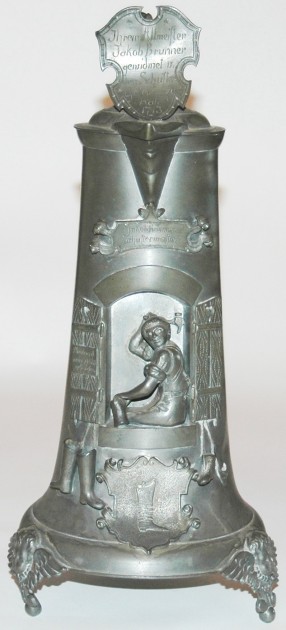 ▲Boot maker – pewter “Niche tankard ” – by Weygang, German, Ca. 1890 -1920. For more info on these type of steins, see: http://www.steveonsteins.com/future-4-the-famile-weygangs-steins-and-servers
▲Boot maker – pewter “Niche tankard ” – by Weygang, German, Ca. 1890 -1920. For more info on these type of steins, see: http://www.steveonsteins.com/future-4-the-famile-weygangs-steins-and-servers
Shakespearian vessels-
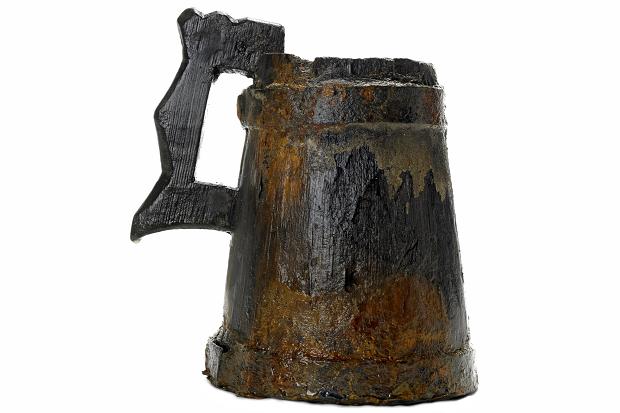
SHEET BRASS, BEER MUG- STAMPED OR PRESSED DESIGN, NOT HAND WORKED – – BELGIUM OR FRANCE CA MID 1800’S ONWARDS 5.6 INCH TALL [FWTD]
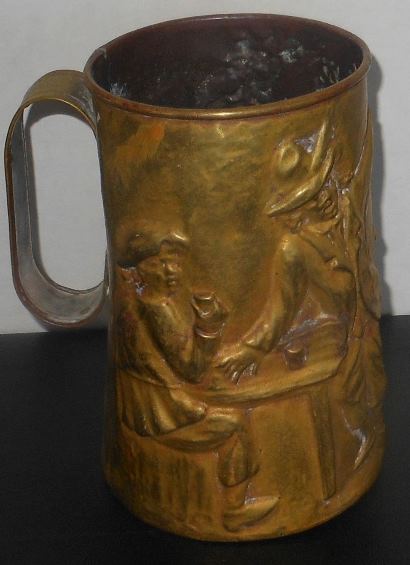
SHELF PIECE – THIS RESERVIST STEIN HAS A GUM FILLED HOLE IN LITHOPHANE – DAMN SHAME ] BUT AS ONE STEIN AUCTIONEER SAID TO ME – “THEY ARE ALL SHELF PIECES.”
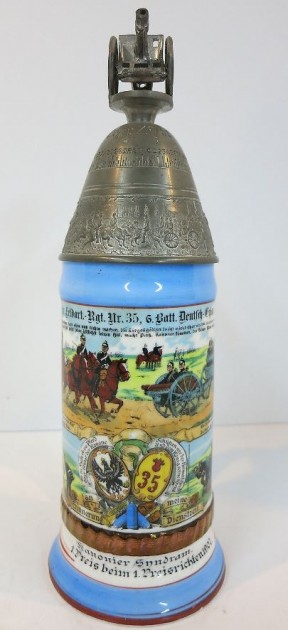
Two Late 17th Century Siegburg baluster Jugs
Siegburg steins, jugs – The earliest stoneware mug and steins made in Germany in the 1500’s came from this city/ vicinity . 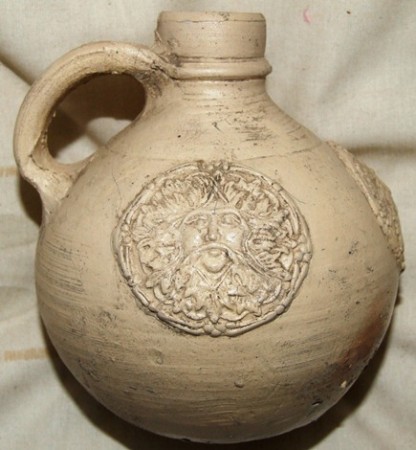
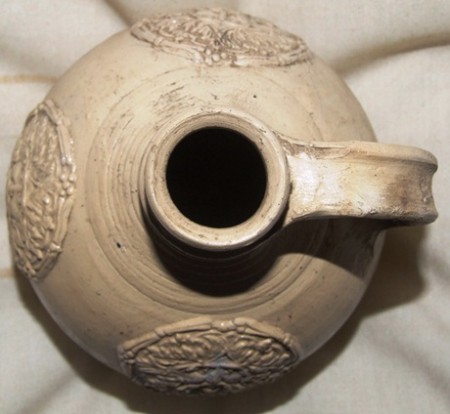
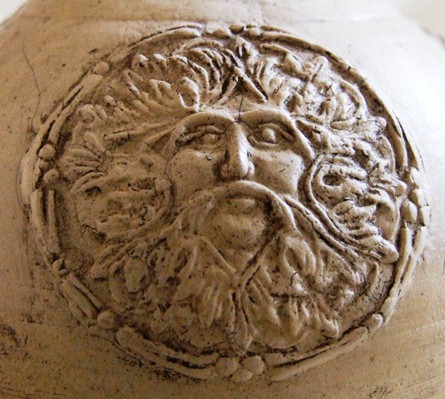 Darren’ B’s Siegberg stoneware “pulle” (bottle) 10 cm = 4 inches tall; with a roundel of “The Green Man” in just great condition. For more info on The Green Man, please see: http://www.steveonsteins.com/the-green-man-vs-the-wild-man
Darren’ B’s Siegberg stoneware “pulle” (bottle) 10 cm = 4 inches tall; with a roundel of “The Green Man” in just great condition. For more info on The Green Man, please see: http://www.steveonsteins.com/the-green-man-vs-the-wild-man 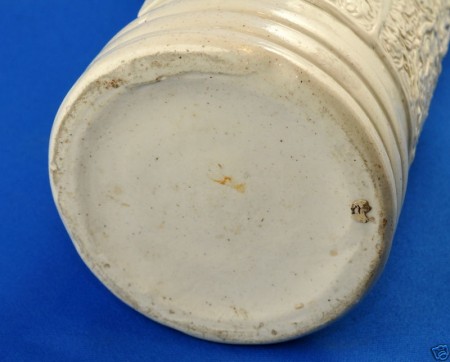 Siegberg steins, reproductions (some, not all – The originals were spun on a wheel, then an additional mass of clay was added to form the base. This bottom on the originals most always shows cracks after firing, and never had a rounded edge and indented base as shown in the photo.
Siegberg steins, reproductions (some, not all – The originals were spun on a wheel, then an additional mass of clay was added to form the base. This bottom on the originals most always shows cracks after firing, and never had a rounded edge and indented base as shown in the photo. 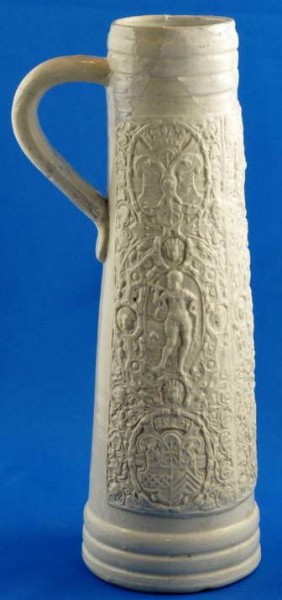 A reproduction Siegberg, but one of “older” fakes, say about 1880 -1900.
A reproduction Siegberg, but one of “older” fakes, say about 1880 -1900. 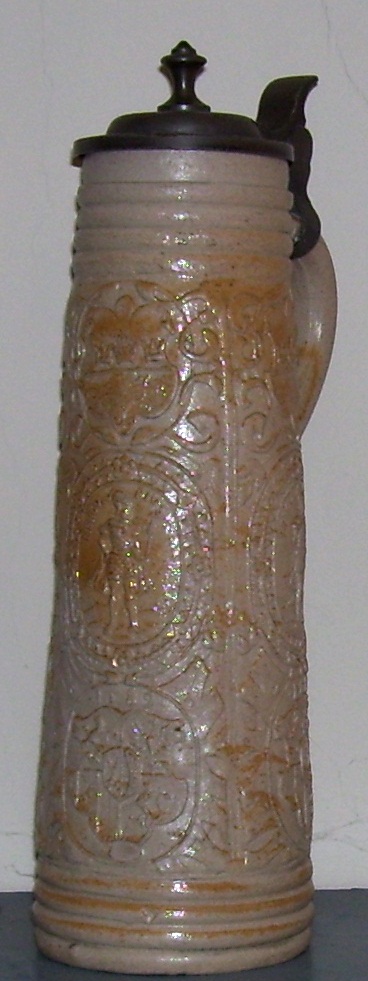 A much older ‘fake’ than 1900’s. Has added discoloration on it. Applied I believe, but I am not an expert on that, just an old collector. [JS] .
A much older ‘fake’ than 1900’s. Has added discoloration on it. Applied I believe, but I am not an expert on that, just an old collector. [JS] . 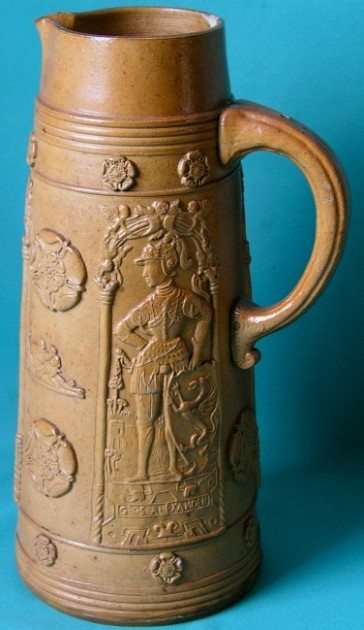 A much younger reproduction, say 1900’s. The molded handle is the first give away. Sheffield Plate, Old – Tankard’s and “Canns” made in England, Circa 1750’s through about the 1860’s when “Electroplating” took the lead. For more information and photos examples see: Old Sheffield Plate Shiny beer stein lid, inside – If the lid is dark on the outside, and bright or semi-bright on the inside this is most often a sign of an older piece. Lids were custom fit to the steins to fit rather tightly. So over time the air will oxidized the pewter lid’s outside but not as much on the inside. Say from the late 1950’s on Reservist reproductions steins and on many others the lids were made /treated to look older. They would be dipped into a mild acid solution so the pewter would appear to have been oxidized. That process was and is still successful today as lots of individuals buying these steins don’t realize the bottom of the lid should be bright / brighter than the top. A dark staining of the lids is obvious on most of the older Reservist’s.
A much younger reproduction, say 1900’s. The molded handle is the first give away. Sheffield Plate, Old – Tankard’s and “Canns” made in England, Circa 1750’s through about the 1860’s when “Electroplating” took the lead. For more information and photos examples see: Old Sheffield Plate Shiny beer stein lid, inside – If the lid is dark on the outside, and bright or semi-bright on the inside this is most often a sign of an older piece. Lids were custom fit to the steins to fit rather tightly. So over time the air will oxidized the pewter lid’s outside but not as much on the inside. Say from the late 1950’s on Reservist reproductions steins and on many others the lids were made /treated to look older. They would be dipped into a mild acid solution so the pewter would appear to have been oxidized. That process was and is still successful today as lots of individuals buying these steins don’t realize the bottom of the lid should be bright / brighter than the top. A dark staining of the lids is obvious on most of the older Reservist’s. 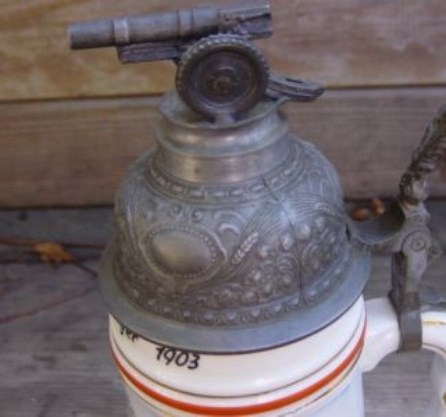 ▲Typical coloration of a chemically treated lid of a reproduction. [
▲Typical coloration of a chemically treated lid of a reproduction. [ 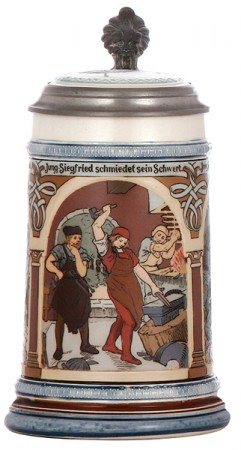 Siegfred – A subject of many beer steins. A German / Norse folk hero of the first part of the “Nibelungenlied.” A prince of the Netherlands, Siegfried obtains a hoard of treasure by killing the dragon “Fafner”; he marries the Burgundian Kriemhild, and helps her brother Gunther to win Brunhild before being killed by Hagen. His Norse equivalent is Sigurd. Shown: Siegfred on a V & B Mettlach stein, No. 2394.
Siegfred – A subject of many beer steins. A German / Norse folk hero of the first part of the “Nibelungenlied.” A prince of the Netherlands, Siegfried obtains a hoard of treasure by killing the dragon “Fafner”; he marries the Burgundian Kriemhild, and helps her brother Gunther to win Brunhild before being killed by Hagen. His Norse equivalent is Sigurd. Shown: Siegfred on a V & B Mettlach stein, No. 2394. 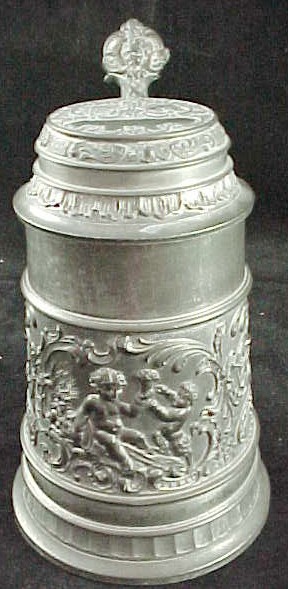 Silenus – The God Bacchus ‘s faithful companion. He was a satyr, and is wrongly called Bacchus by a lot of unread people and even some classy museums, who should know better , when describing Bacchanalian scenes. He is also called “Pan” even though there is not a”Pan” flute anywhere in the scene. Shown above ▲: Silenus [R] and Bacchus as children on a .5 liter pewter relief stein, Ca. 1
Silenus – The God Bacchus ‘s faithful companion. He was a satyr, and is wrongly called Bacchus by a lot of unread people and even some classy museums, who should know better , when describing Bacchanalian scenes. He is also called “Pan” even though there is not a”Pan” flute anywhere in the scene. Shown above ▲: Silenus [R] and Bacchus as children on a .5 liter pewter relief stein, Ca. 1
890. Below ▼ Silenus as shown on a large pewter French wine server. Early 1800’s. [FWTD] 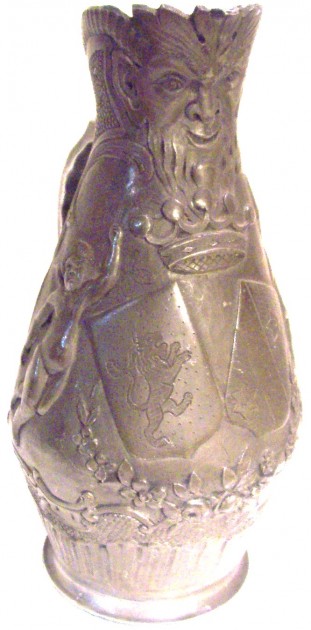
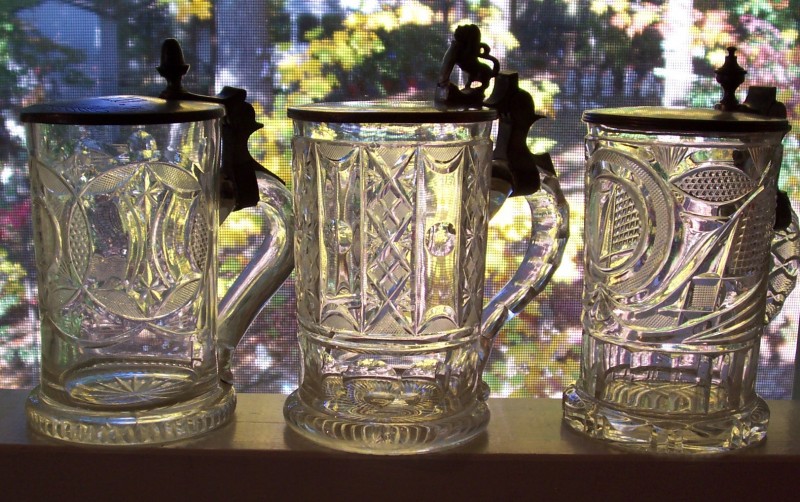 Silesia – A political area of old Austria, just north of old Bohemia. Lots of so called “Bohemian” glass hüttes were located there. (I have a theory that the steins with the cut handles in the form of a “Chevron” or “Herring bone” mostly came from old Silesia. But, Gambrinus Stein Club’s glass stein “expert” Jim Sauer, thinks I’m incorrect (and it wouldn’t be the first time.)
Silesia – A political area of old Austria, just north of old Bohemia. Lots of so called “Bohemian” glass hüttes were located there. (I have a theory that the steins with the cut handles in the form of a “Chevron” or “Herring bone” mostly came from old Silesia. But, Gambrinus Stein Club’s glass stein “expert” Jim Sauer, thinks I’m incorrect (and it wouldn’t be the first time.) 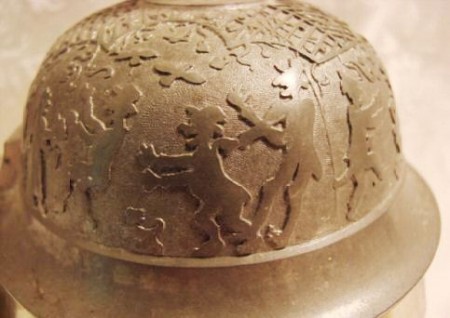 Silhouette lids, pewter , on steins – As shown; these are of course molded and not cut or engraved.
Silhouette lids, pewter , on steins – As shown; these are of course molded and not cut or engraved. Silver on (over) copper steins – Basically these will be: [a] “Old Sheffield Plate” or [b] electro-silvered or [c] electro-typed steins. Copper is most often the base metal with a thin layer of silver over it. Within 100 years most of the silver has usually worn away, sometimes creating a lovely effect, sometimes not. Shown: A silver on copper stein with coin impressions in the body – not real coins! It has lost almost all its plating. After electo-plating was discovered in 1840, most all the European metal firms went crazy putting out this type of material. This one above is German, Circa 1860 -70. The steins looks great when polished up! [FWTD] . See also: “Old Sheffield Plate.”
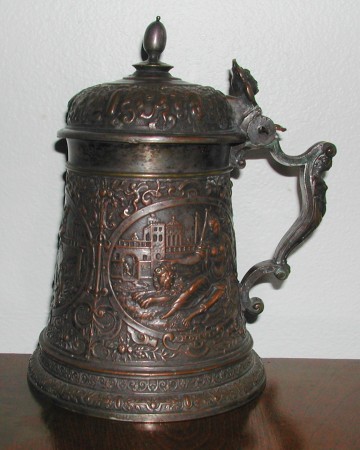 Another example. This one is modeled after a 1600’s pewter tankard from Saxony; This one made by an unknown maker. 7.5 inches tall. Ca. 1870. [BP] See: http://www.steveonsteins.com/silver-plated See also the book: “Pewter of the Western World”, by Hornsby, for examples of the pewter one. Silverplate — A base metal, usually either Britannia, nickel silver or copper, coated with a layer of pure silver by (now) electroplating or electrotyping. Process was established in Germany sometime after the 1840’s = when it was first made in England. See also: “Old Sheffield Plate,” “Electro-typing,” and “WMF.”
Another example. This one is modeled after a 1600’s pewter tankard from Saxony; This one made by an unknown maker. 7.5 inches tall. Ca. 1870. [BP] See: http://www.steveonsteins.com/silver-plated See also the book: “Pewter of the Western World”, by Hornsby, for examples of the pewter one. Silverplate — A base metal, usually either Britannia, nickel silver or copper, coated with a layer of pure silver by (now) electroplating or electrotyping. Process was established in Germany sometime after the 1840’s = when it was first made in England. See also: “Old Sheffield Plate,” “Electro-typing,” and “WMF.” ![USE FOR WMF [Q] -LID](http://www.steveonsteins.com/wp-content/uploads/2011/01/USE-FOR-WMF-Q-LID.jpg) Silver plated lids –By far the biggest producer of silver plated lids was WMF, who produced this lid for a 1 liter hand painted V & B Mettlach stein. Hand enameled scene of the German warrior “Hermann.” Unmarked but probably van Hauten’s workshop. [FWTD] SEE: HERMANN’S STORY: http://www.steveonsteins.com/hermanns-story
Silver plated lids –By far the biggest producer of silver plated lids was WMF, who produced this lid for a 1 liter hand painted V & B Mettlach stein. Hand enameled scene of the German warrior “Hermann.” Unmarked but probably van Hauten’s workshop. [FWTD] SEE: HERMANN’S STORY: http://www.steveonsteins.com/hermanns-story
Simulated Copper Flagon BY Royal Doulton
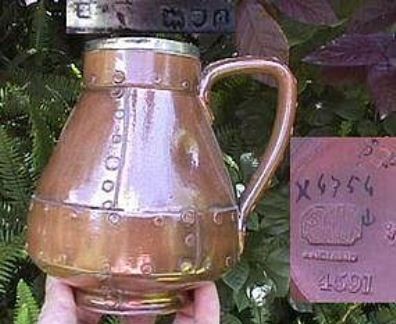
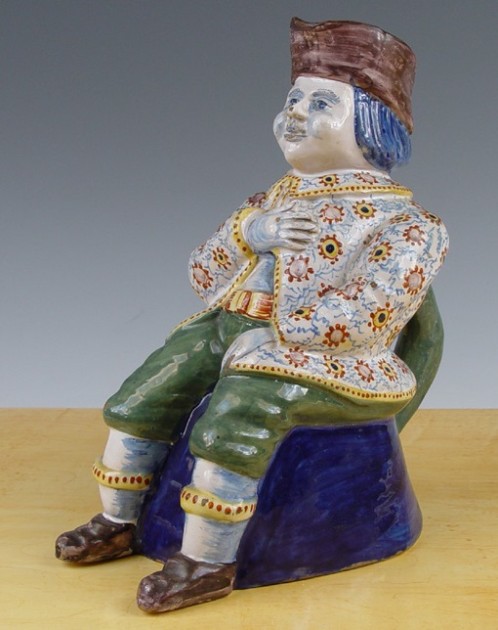 Sitting on rocks – Character steins– Man and woman,usually used as servers. Made in the Netherlands, modern Belgium area and France. . Some of the older ones are quite sizable (and expensive when found . See: Man and woman for more photos.
Sitting on rocks – Character steins– Man and woman,usually used as servers. Made in the Netherlands, modern Belgium area and France. . Some of the older ones are quite sizable (and expensive when found . See: Man and woman for more photos. 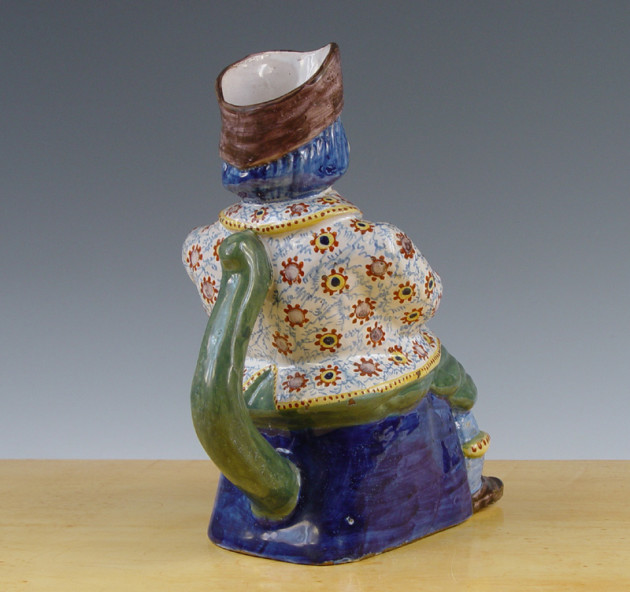 L
L 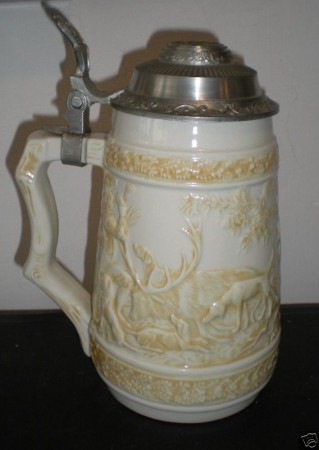 Sitzendorf Beer Steins – Porcelain stein makers – See: http://www.steinmarks.co.uk/pages/pv.asp?p=stein1 Six sided star – The Brewer’s Star-
Sitzendorf Beer Steins – Porcelain stein makers – See: http://www.steinmarks.co.uk/pages/pv.asp?p=stein1 Six sided star – The Brewer’s Star- 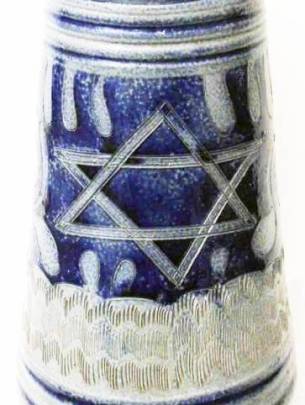
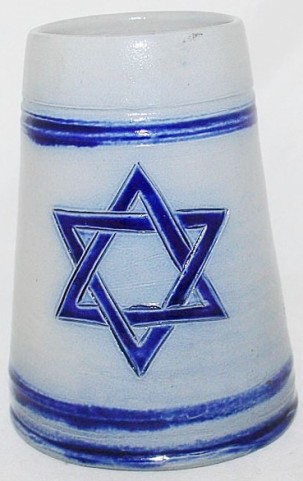 Of course, there has been much speculation that the brewer’s emblem was somehow descended from the Star of David — a curious match to the brewer’s star. It has even been suggested that King David himself was a brewer. But others assert that the emblem’s use by beer-makers originated independently of the Jewish Star, and has no historical connection thereto. Of course the German beer brewers stopped using this as a symbol under the Nazis! Shown ▲: Two examples of the “brewer’s star,”engraved on the bodies of Westerwald drinking vessels [L] On a beer server Circa 1850, [R] Mug, Circa 1980 .
Of course, there has been much speculation that the brewer’s emblem was somehow descended from the Star of David — a curious match to the brewer’s star. It has even been suggested that King David himself was a brewer. But others assert that the emblem’s use by beer-makers originated independently of the Jewish Star, and has no historical connection thereto. Of course the German beer brewers stopped using this as a symbol under the Nazis! Shown ▲: Two examples of the “brewer’s star,”engraved on the bodies of Westerwald drinking vessels [L] On a beer server Circa 1850, [R] Mug, Circa 1980 . 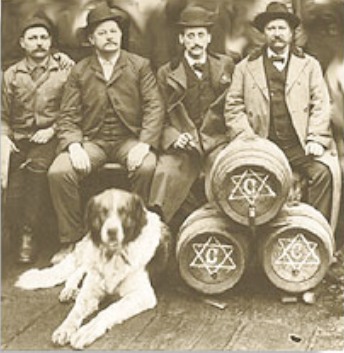 Some of a small brewery’s staff sitting by their kegged product. . The Star of David – “In the 17th century, the Shield of David as the hexagram began to represent the Jewish commuinty (sic) generally, when the Jewish quarter of Vienna was formally distinguished from the rest of the city by a boundary stone having the hexagram on one side and the Christian cross on the other. By the 18th century, the Shield appeared to represent the Jewish people in both secular (politics) and religious (synagogue) contexts. Then in the 19th century, it began to signify the Jewish people internationally, when the early Zionist movement adopted it as the symbol of the Jewish people, after the Dreyfus affair in France in the 19th century. From here, other Jewish community organizations adopted it too. In the 20th century, Nazi-Era Germany enacted laws forcing Jews to sew a yellow Shield of David in the form of two overlapping triangles onto their clothing to conspicuously identify themselves, while the leadership carried out its policy of genocide against them during War World 2. With its establishment in 1948, the State of Israel adopted the Shield of David for the Flag of Israel.”
Some of a small brewery’s staff sitting by their kegged product. . The Star of David – “In the 17th century, the Shield of David as the hexagram began to represent the Jewish commuinty (sic) generally, when the Jewish quarter of Vienna was formally distinguished from the rest of the city by a boundary stone having the hexagram on one side and the Christian cross on the other. By the 18th century, the Shield appeared to represent the Jewish people in both secular (politics) and religious (synagogue) contexts. Then in the 19th century, it began to signify the Jewish people internationally, when the early Zionist movement adopted it as the symbol of the Jewish people, after the Dreyfus affair in France in the 19th century. From here, other Jewish community organizations adopted it too. In the 20th century, Nazi-Era Germany enacted laws forcing Jews to sew a yellow Shield of David in the form of two overlapping triangles onto their clothing to conspicuously identify themselves, while the leadership carried out its policy of genocide against them during War World 2. With its establishment in 1948, the State of Israel adopted the Shield of David for the Flag of Israel.” 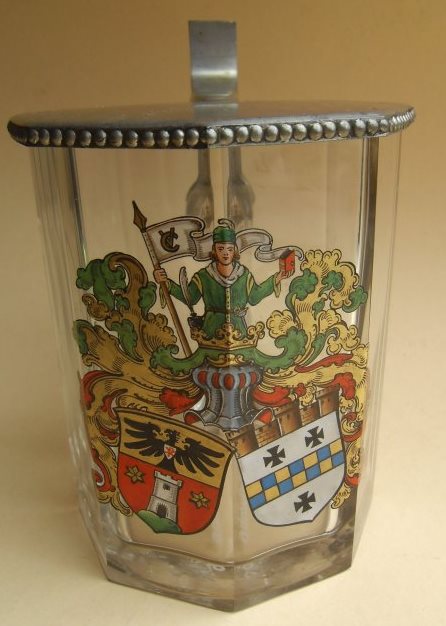 Six sided beer steins (Also see Hexagonal) – While not common these can be found. They are not the easiest stein to drink out of. .Above▲ PUG coat of arms on .5 liter blown glass . Lid enscribed to a magic club. Ca. 1900. Unusual. Unknown maker SJ & SG – A rather good copper stein and server in maker located in Munich.
Six sided beer steins (Also see Hexagonal) – While not common these can be found. They are not the easiest stein to drink out of. .Above▲ PUG coat of arms on .5 liter blown glass . Lid enscribed to a magic club. Ca. 1900. Unusual. Unknown maker SJ & SG – A rather good copper stein and server in maker located in Munich. 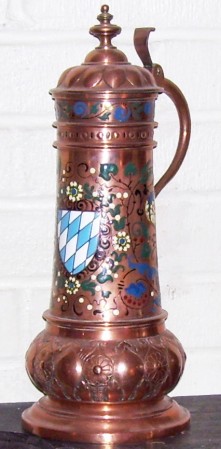 For many examples see: http://www.steveonsteins.com/copper-stein-bohemian-vs-bavarian
For many examples see: http://www.steveonsteins.com/copper-stein-bohemian-vs-bavarian 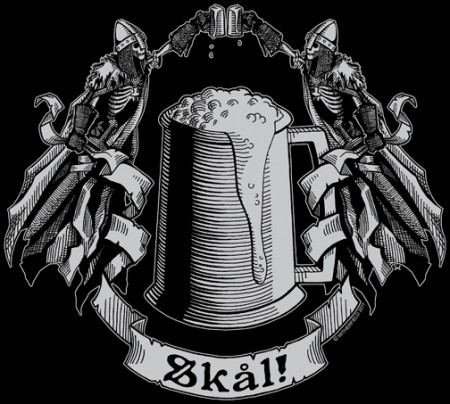 Skàl – (Pro: SKOOL) meaning “skull” – Scandinavian term for “A toast to your health!” It comes from the ancient pre-Viking Celtic custom of drinking from you dead enemy’s cleaned out sk
Skàl – (Pro: SKOOL) meaning “skull” – Scandinavian term for “A toast to your health!” It comes from the ancient pre-Viking Celtic custom of drinking from you dead enemy’s cleaned out sk
ull !! 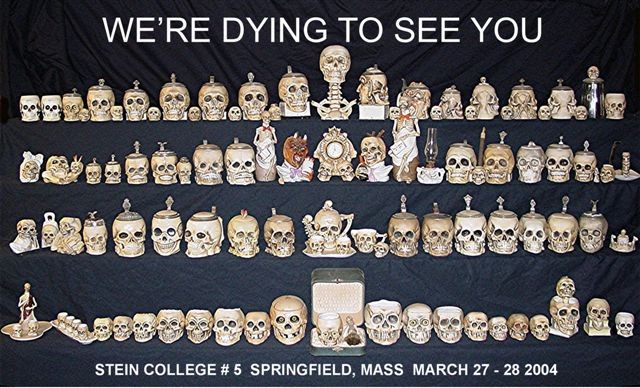 What is left of the ancient custom! Skull steins, porcelain mostly – Characters = Self explanatory. David Harr’s collection. Skirt Base — Chiefly on silver and pewter flagons and tankards, flaring outward to raise the body from table level.
What is left of the ancient custom! Skull steins, porcelain mostly – Characters = Self explanatory. David Harr’s collection. Skirt Base — Chiefly on silver and pewter flagons and tankards, flaring outward to raise the body from table level. 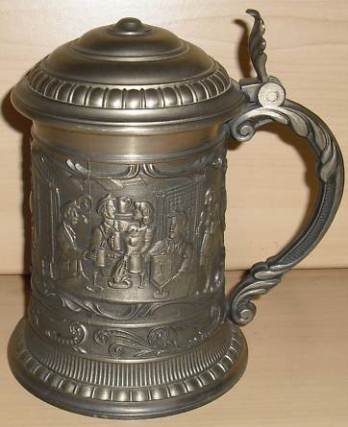 SKS ZINN – Zinn (95%) on modern pewter steins (95% = 95 percent lead free.) SKS are makers of new (cheap) pewter steins. Circa 1980 [+] . also seen:
SKS ZINN – Zinn (95%) on modern pewter steins (95% = 95 percent lead free.) SKS are makers of new (cheap) pewter steins. Circa 1980 [+] . also seen: 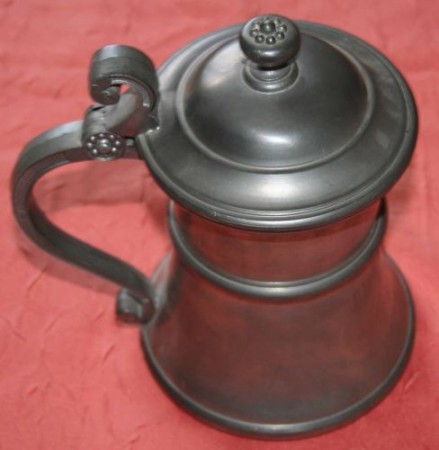 SKS Reinzinn – SKS zinn – Very modern producer of pewter steins. Above: 8 inches tall. See: http://www.steinmarks.co.uk/pages/pv.asp?p=stein1
SKS Reinzinn – SKS zinn – Very modern producer of pewter steins. Above: 8 inches tall. See: http://www.steinmarks.co.uk/pages/pv.asp?p=stein1 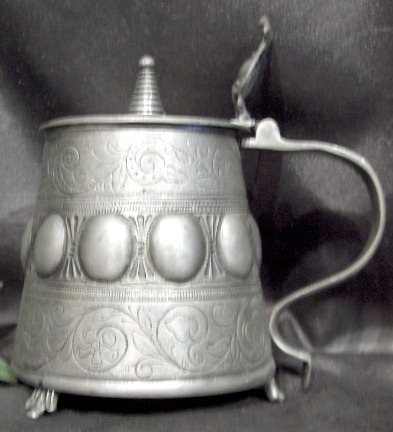
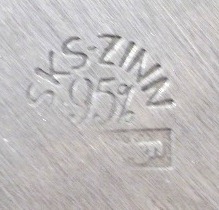 95% mark = New!!
95% mark = New!!
Skull steins – Others ▼; and see Skal (above) ▲= David Harr’s “Beer Stein College” display.
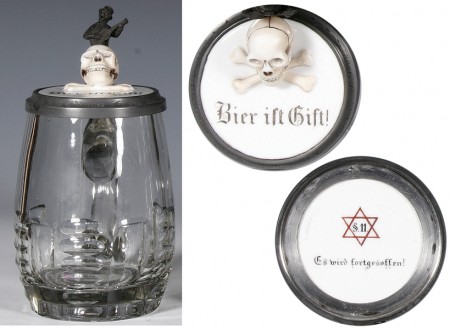 Above ▲-Glass stein, .5L, blown, cut, porcelain inlaid lid of a skull. Brewer’s star on bottom of lid. .
Above ▲-Glass stein, .5L, blown, cut, porcelain inlaid lid of a skull. Brewer’s star on bottom of lid. . 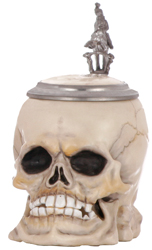
For a few (3?) German Hussar regiments used this type ▲of Skull character as their beer stein of choice when they mustered into the reserves.
Slip — A much watered-down clay or porcelain recipe that is sufficiently liquid for use in coating, gluing, or casting pieces of ceramic material.
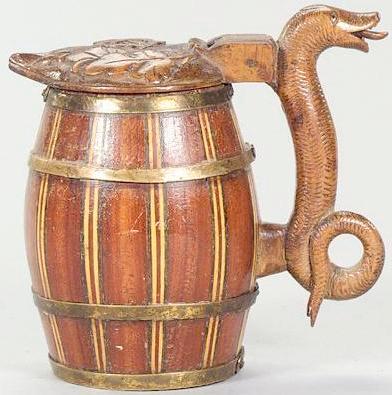 Slovakian steins, wooden – From Slovkia, Eastern part of Hungry. Showing the typical alternating colored staves / slats. This one with a jazzed up design adding redish and cream colored wood. Pitched inside. Circa 1870. For more on Wooden steins see: http://www.steveonsteins.com/wooden-steins
Slovakian steins, wooden – From Slovkia, Eastern part of Hungry. Showing the typical alternating colored staves / slats. This one with a jazzed up design adding redish and cream colored wood. Pitched inside. Circa 1870. For more on Wooden steins see: http://www.steveonsteins.com/wooden-steins
Slovakian wooden character mugs. – Extremely hard to find in good condition. Shown ▲: Two such mugs, six inches to top of man’s head. [FWTD]
Small beer – A noun: 1. Weak or inferior beer. 2. Unimportant things; trivia.
. 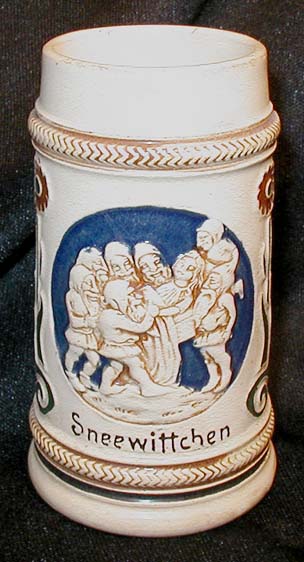
Sneewittchen – German for “Snow White”-shown ▲ a 1/8th liter pottery kinder mug For more see:http://www.steveonsteins.com/some-german-fairy-tales-on-kinders-wrk-draft-stdtd-11-27
SNOWMAN Character stein, .5L, porcelain, marked Musterschutz, by Schierholz, CHARACTERS I LIKE , TSACO
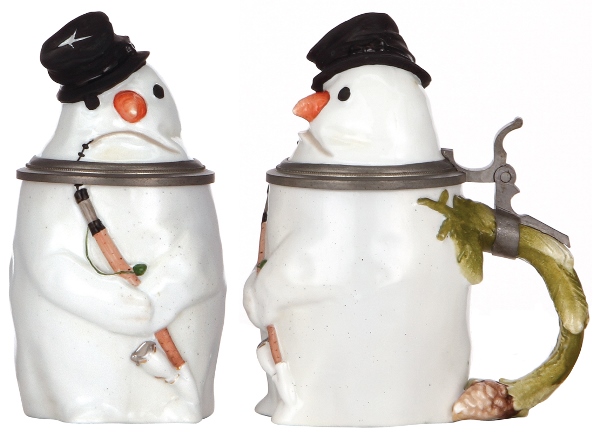
Soccer (Fusball) steins – Self explanatory. For as popular as the sport was / is there are not many steins dedicated to it; mostly character soccer balls as shown below
▼ .5 liter pottery relief, Ca. 1910.
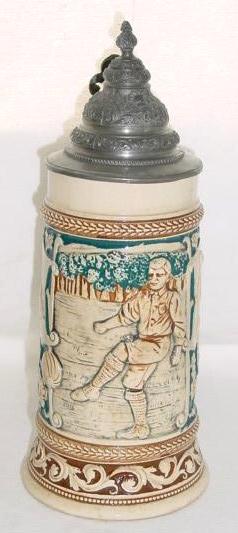
▼ Unusual decor. The three footed ball is resting on a plinth.
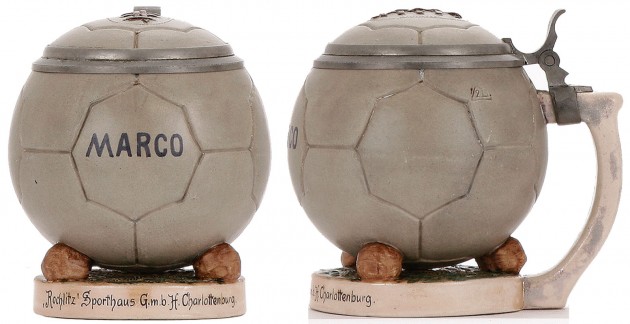
▼New pottery stein, say 1990’s. If this stein was ever used, how long do you think the thumblift would stay intact? As popular as this sport is in Europe there are many soccer balls steins out there, old and new, here are a few. The black on white versions are popular as gifts to young players in the USA ever since about the 1960’s when youth teams took off here .
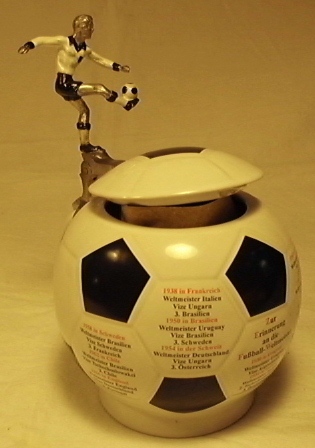
▼ This would be my favorite. A 3/4 liter replica of an an early machine stitched leather soccer ball by Hanke. 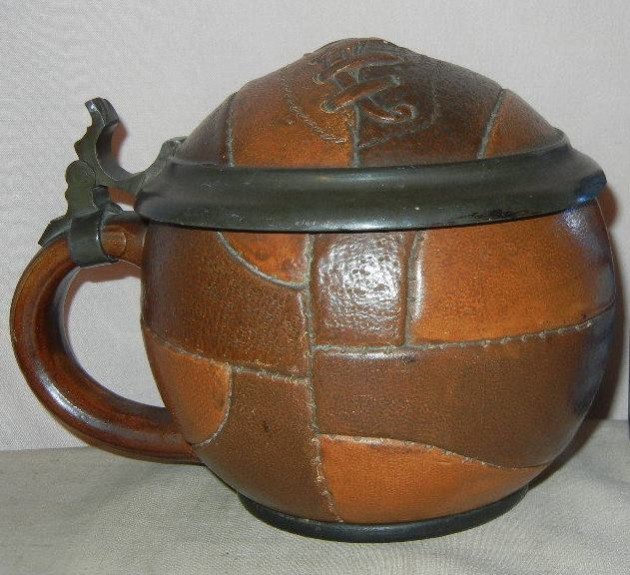
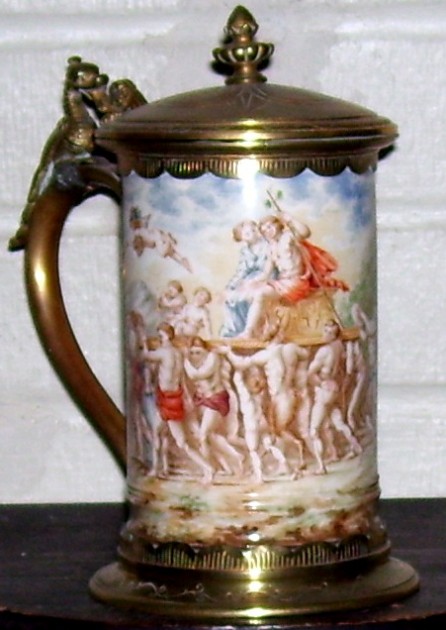 Soft-paste porcelain – The earliest attempt to make porcelain in Europe. This is a much softer surface and looks more like creamware in appearance. Shown: An Italian stein with hand painted scene of Bacchus and his entourage. Re-established (newer) brass mounts and handle, as original handle was broken off (intentionally?) A great looking piece, as good as any Meissen. Signed: “CLW, 1852.” [FWTD] This stein took a bad dive onto the hardwood floor of my living room during the 2011 Central Virginia’s ” 6 .9″ earthquake,;never been “quite right since!” .
Soft-paste porcelain – The earliest attempt to make porcelain in Europe. This is a much softer surface and looks more like creamware in appearance. Shown: An Italian stein with hand painted scene of Bacchus and his entourage. Re-established (newer) brass mounts and handle, as original handle was broken off (intentionally?) A great looking piece, as good as any Meissen. Signed: “CLW, 1852.” [FWTD] This stein took a bad dive onto the hardwood floor of my living room during the 2011 Central Virginia’s ” 6 .9″ earthquake,;never been “quite right since!” . 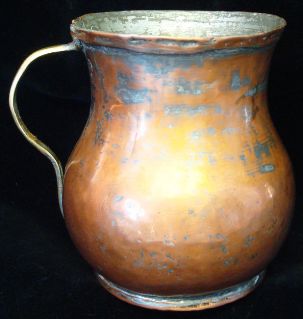
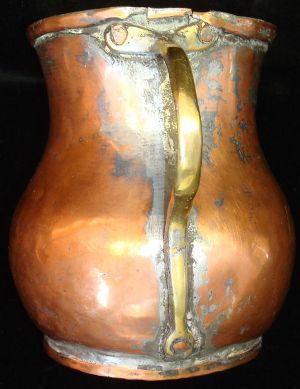 Solder, lead – Used for utilitarian repairs and not reconstruction of good items especially on old silver, copper or bronze. Shown: A very utilitarian repair on a well used copper mug from the middle east. Circa mid 1700’s at least. One has to remember this was not the “throw away” or “plastic” economy of the USA of the late twentieth century. The below photo show drops of solder the smith just left on the bottom without trying to clean it up.
Solder, lead – Used for utilitarian repairs and not reconstruction of good items especially on old silver, copper or bronze. Shown: A very utilitarian repair on a well used copper mug from the middle east. Circa mid 1700’s at least. One has to remember this was not the “throw away” or “plastic” economy of the USA of the late twentieth century. The below photo show drops of solder the smith just left on the bottom without trying to clean it up. 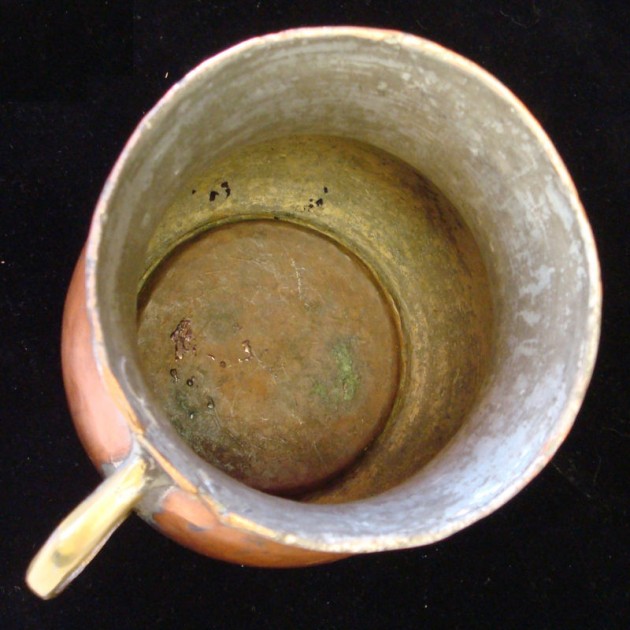 “Solder, silver” – A alloy of silver with other low heat metals, but with no lead! It is used for the best metal repairs and will not run as regular lead solder does. Souvenier steins, general type – This pertain to most of the moderately old relief beer stein found on the seconday market today [read that ebay]. When the us forces occupied Germany after and the long after the World war II they would at least buy one [then new] stein for themselves and maybe one of two for friends and family back home. Once the German pottery firms got back up and running also found a market here in English (but not England for obvious reasons ) speaking cvounties for import of the (then) newly made beer steins. Most new collector start out by buying one or two of these as starters and after learning about all the other nicer and older varieties quickly give them away.
“Solder, silver” – A alloy of silver with other low heat metals, but with no lead! It is used for the best metal repairs and will not run as regular lead solder does. Souvenier steins, general type – This pertain to most of the moderately old relief beer stein found on the seconday market today [read that ebay]. When the us forces occupied Germany after and the long after the World war II they would at least buy one [then new] stein for themselves and maybe one of two for friends and family back home. Once the German pottery firms got back up and running also found a market here in English (but not England for obvious reasons ) speaking cvounties for import of the (then) newly made beer steins. Most new collector start out by buying one or two of these as starters and after learning about all the other nicer and older varieties quickly give them away. 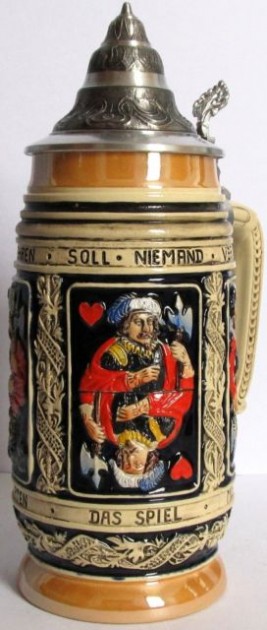 Found around the base and the lip is the orange brown coloration of steins produced after WWII . I don’t know the exact date or company that started this but is a good indicator of relative age.
Found around the base and the lip is the orange brown coloration of steins produced after WWII . I don’t know the exact date or company that started this but is a good indicator of relative age. 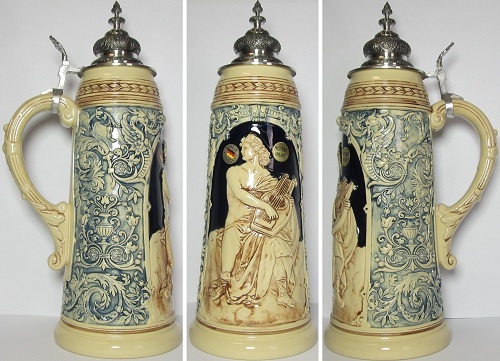 A much newer type of “souvenir stein” made for the USA market. These are replicas of the older nicer pottery relief, and are usually now reproduced in limited editions .
A much newer type of “souvenir stein” made for the USA market. These are replicas of the older nicer pottery relief, and are usually now reproduced in limited editions . 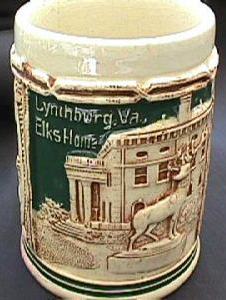 Kinder souvenir mug from Lynchburg Va.- Sold for $77.50 back in 9-05. SOUVENIR STEINS MUGS, KINDERS – Over the past 100 and so years German made and imported American City souvenir steins in the 1/8th liter variety have become collectable, some commanding prices in the $50 to $70 range. German city souvenir steins larger than 1/8th liter are not very collectable (too many? or what is the sense in having a city you’ve never gone to?) FOR MORE INFO SE: http://www.steveonsteins.com/kinder-steins-page-1-13rd-of-article-text-only
Kinder souvenir mug from Lynchburg Va.- Sold for $77.50 back in 9-05. SOUVENIR STEINS MUGS, KINDERS – Over the past 100 and so years German made and imported American City souvenir steins in the 1/8th liter variety have become collectable, some commanding prices in the $50 to $70 range. German city souvenir steins larger than 1/8th liter are not very collectable (too many? or what is the sense in having a city you’ve never gone to?) FOR MORE INFO SE: http://www.steveonsteins.com/kinder-steins-page-1-13rd-of-article-text-only 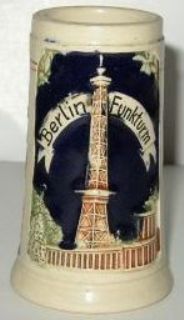 [END – SOK – 55 – R5] WISH TO CONTACT ME, STEVE (STEPHEN) ? =
[END – SOK – 55 – R5] WISH TO CONTACT ME, STEVE (STEPHEN) ? =  “Don’t worry about old age it doesn’t last long!”
“Don’t worry about old age it doesn’t last long!”

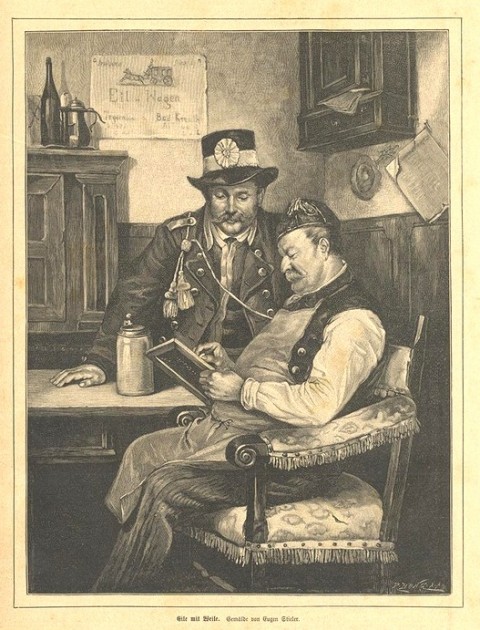

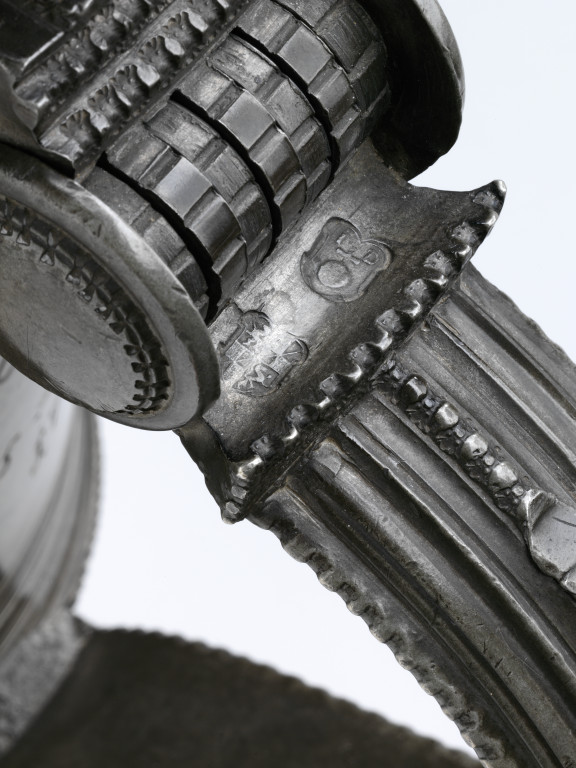








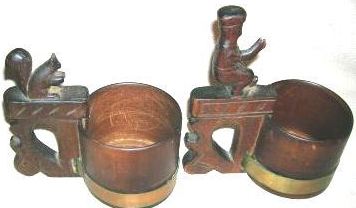
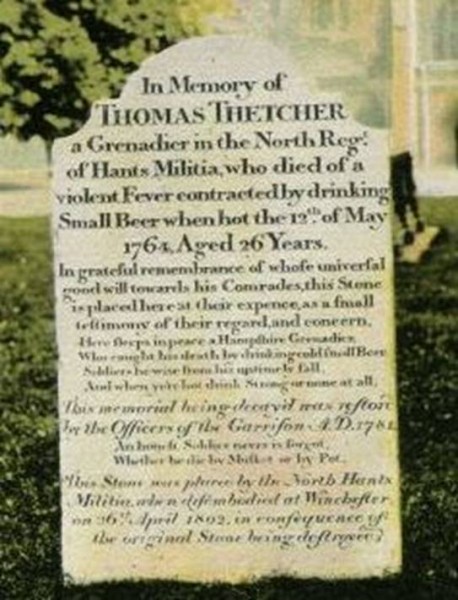
Leave a Reply